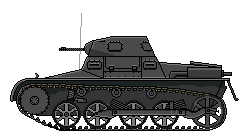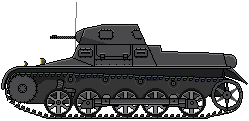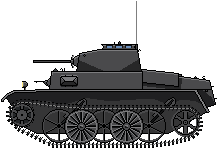Panzerkampfwagen I
The first one
World War I saw the rise of the tank, which was used by the western Allies to help their infantry breach the enemy trench lines. These early tanks, like the British Mark IV and French Saint-Chamond, were hulking giants, heavily armored for brute force. When used correctly, they did prove decisive, pushing the Entente powers back home. This success, however, became a confirmation bias on the Allied side: because they won, their use of armour had been correct. Tanks should be slow moving, heavily armoured mobile bunkers, assisting the infantry. Now, some people didn't agree, but the general trend, post-WW1, was towards heavy and slow. Germany did use some tanks -their own, or captured ones- but they never got the concept to work for them, and lost the war for a multitude of reasons. This spared them from drawing the same flawed conclusions that the Allies did, and to make things worse (or better), they were forbidden from developing new weapons or doctrine. After a few years of internal Stahlhelm chaos, however, the country felt the need for a normal army. Generaloberst Hans von Seeckt got the job and because the army had to be small, only the best people were hired. For weapons design, they could take a clean sheet and go from there!
The German philosophy for using tanks was different from the allies: instead of having lumbering bunkers to assist the infantry, the German tanks were to probe the enemy lines fore weaknesses, punch through those and then create havoc in the enemies' rear. So they needed smaller, lighter vehicles that could scout around, zip from here to there in an active manner and work together, like horse cavalery of the previous centuries. The Panzer 1 was just that: very small (VW Golf-sized), fast, and equipped with a radio. No one expacted it to fight, though, it was just for development and training. (The latter was much needed, at some point one could see German elite soldiers running around the training fields, holding signs that read "I'm a tank!".) Hitler, though, was in a hurry. Not wanting to wait until his generals were finally ready (the cretiunous, gutless weaklings!), he charged ahead with what he had. First in Spain, where it met Soviet BT-s and T-26s; those were far superior. It was clear the vehicle was just not good enough end an update was needed. The remaining chassis were used until the end of the war, though, mainly as gun carriers and munition tractors, a bit like the UK's bren carriers.

Sd.Kfz.101 Panzerkampfwagen I Ausführung A
The first "production" run of this vehicle: a two man crew, four road wheels using Schraubenfeder, a very noisy Krupp M305 engine, two MG13's and a radio, but receive only.
RAL 7016

PzKpfw I Ausf. B
As soon as model A was rolling, Waffenprüfamt 6 demanded an upgrade, resulting in a new Maybach engine, an extra road wheel and a two-way radio. About 1500 of these machines were built.
RAL 7016

PzKpfw I Ausf. C
Part of the VK series of tanks and developed by Ernst Kniepkamp, Ausf. C was to be a racing tank with zero armour. Understandibly, their crews didn't like them very much.
Last updated 3 mins ago